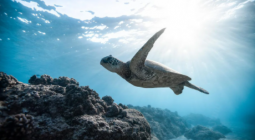Offshore fish farms: a new wave of food production … or the ‘wild west’ of ocean pollution?
The enclosures stretch the length of an Olympic-size swimming pool, but from above they appear as floating dots scattered across the ocean. Inside, fish mill about as the submerged pens sway to the currents of the open sea.
Known as offshore fish farms, these structures have appeared around the world in recent years. Their proliferation in open waters, often sitting several miles off coastlines, has sparked heated debate: some see them as the next frontier for the sustainable production of fish such as Atlantic salmon, seabass and cobia; others describe them as “factory farming of the sea”.
What almost everyone can agree on is that these deep-sea farms are poised to surge in the coming years. Between 1961 and 2017, global demand for fish grew an average of 3.1% a year, leaving companies scrambling.
“Aquaculture is the fastest growing form of food production in the world,” says Robert Jones, the Nature Conservancy’s global lead for aquaculture. “And we’re at the very beginning of this industry. Now is the chance to influence where it goes.”
The Nature Conservancy has long viewed offshore farms as a potential gamechanger for fish production, albeit one threaded with huge challenges. “It is growing rapidly around the world, and it’s an opportunity for conservation,” said Jones. “But it can also potentially come at the detriment of the environment.”
What attracts the organisation is the possibility that the farms could ease pressure on wild fish populations. In 1974, about 10% of the fish stocks in the world’s marine fisheries were being depleted too quickly for species to replace themselves, according to the UN’s Food and Agriculture Organization. By 2017, this proportion had climbed to 34%.
The deep-sea locations of offshore farms are also seen as a plus, because stronger currents may dilute waste and avoid the coastal degradation often seen in fish farms located in bays and estuaries.
Others argue that the environmental concerns outweigh any potential benefits. Last month, a coalition of nine groups in the US, including marine conservation organisations and the Quinault Indian Nation, filed a notice of intent to sue the US Army Corps over its decision to issue a nationwide permit that could pave the way for finfish aquaculture facilities to be built in state and federal waters.
It’s branded as a solution to overfishing but, in order to feed the fish, you have to get more wild fish Meredith Stevenson, Center for Food Safety
The coalition warns that the blanket approval was granted without fully considering the effect farms could have on threatened and endangered species. The farms often come with a rise in marine traffic, the groups say, which could increase the risk of vessel strikes, particularly as animals are lured to the site by the scent of feed.
They list a slew of additional concerns, from worries that the constant flow of water through the farms will let feed, antibiotics and faecal matter into open waters to the risk that farmed fish could escape and threaten local ecosystems.
“We look at these as animal factories of the sea,” says Meredith Stevenson, an attorney with the Center for Food Safety, one of the groups behind the legal challenge. “It’s the wild west out there.”
There’s also the risk that the farms will need to rely on small, wild-caught fish as feed. “It’s branded as a solution to overfishing but, in order to feed the fish, you have to get more wild fish,” adds Stevenson.
Fish and shellfish farms have been growing at a dizzying pace around the world, particularly in China. Between 1990 and 2018, fish farming grew 527%, according to the UN’s Food and Agriculture Organization.
Offshore fish farming ranks among the riskiest bets of the sector; enclosures need to be built to withstand the open sea, from metre-high waves to fierce currents, while their remote locations mean any issues are usually more time-consuming and costly to fix. The greater risk of bad weather means that even routine operations need to be put off at times.
Even so, investors have poured tens of millions into the sector. Virginia-based Forever Oceans has raised nearly $120m (£100m) from investors, according to Bloomberg, while a venture fund linked to Walmart heiress Christy Walton has backed half a dozen initiatives related to open-ocean aquaculture.
For many, the lure is the promise of sustainable fish production. “Our fish can feed the world and restore our oceans,” is how Forever Oceans describes its mission. Hawaii-based Ocean Era, which has an offshore farm near Mexico, says its goal is to “soften humanity’s footprint on the seas”. Blue Ocean Mariculture, which raises fish in submersible sea pens near Hawaii, says it will “produce the best-tasting fish without harming the environment”.
Studies delving into the farms have yielded varied results. A 2019 study that collected water samples near submerged fish cages off the coast of Panama concluded that, when located appropriately, offshore farms can produce a relatively small pollution footprint. A 2011 study comparing more than 15,000 southern bluefin tuna farmed offshore and closer to the coast found those grown offshore had reduced mortality and were less prone to sea lice.
But a 2020 perspective published in Nature argued that the high costs associated with offshore farming meant these products would be inaccessible to low-income consumers, suggesting limited scope in alleviating food insecurity. Researchers also argued that the fuel consumed by boats heading to and from the farms could compromise environmental claims.
Overall, the evidence in support of offshore fish farms remains scant, says Jim Walsh, policy director of Food & Water Watch. “The development of these fish farms is far from studied to an extent that could make us feel confident.” The remote locations, he says, would make it “impossible to effectively regulate factory fish farming in a sustainable way in our oceans”.
There is already a lack of oversight of the fishing industry, Walsh says. “To think that we will, all of a sudden, have a regulatory regime that’s going to step in and monitor these factory fish farms is ridiculous.”
40% of arable land is already devoted to food production … there’s got to be new sources Steve Gaines, marine ecologist
A better option may be land-based tanks, where fish are farmed in isolation from the surrounding ecosystem, he says.
Walsh’s view clashes with those who describe offshore fish farming as one of the few realistic options for feeding the planet. Among them is Steve Gaines, dean of the Bren School of Environmental Science and Management at the University of California, Santa Barbara. His perspective shifted after he came across projections suggesting demand for food could double by 2050 as the global population grows and becomes more wealthy.
“My reaction was, ‘oh my God, how are we going to produce that much food?’” Gaines says. “Something like 40% of arable land is already devoted to food production … there’s got to be new sources.” What he landed on was fish farming. “Despite the fact that there are a lot of issues – as there are with any form of food production – it’s the one that has by far the biggest potential for expansion.”
As companies experiment with fish feed derived from products such as insect protein or bacterial-based protein in order to minimise the pressure on wild-caught fish stock, aquaculture could result in a smaller environmental footprint compared with the production of other forms of animal protein, he says.
It makes perfect sense, says Gaines, since most of the fish we consume are cold-blooded, don’t have to fight gravity and have smaller skeletons, meaning they are far more efficient at converting feed to food.
And then there’s the vertical nature of the fish farms. “The surface area to produce a given amount of food is also dramatically less if you can grow them in a liquid environment than on land,” he says. “You can’t stack cows 100 feet high.”
Gaines is quick to list the many caveats of his analysis; it depends heavily on what kinds of species are raised; on fish densities that are low enough to keep diseases from proliferating; and on locations that have high enough water flows to absorb waste generated by the farms.
“There are obvious ways you can do it poorly,” he concludes. “But it can be done well, and the technology is there to do it well. It’s really important – it has lots of implications in terms of the next 30 years and more of the planet.”
Ashifa Kassam




